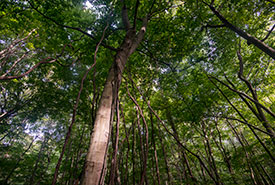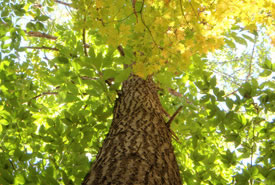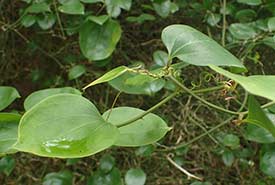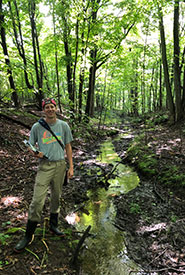Learning new things in familiar places

Forest canopy in Backus Woods, ON (Photo by Neil Ever Osborne)
To most people, warmer weather means soaking up the sun at the beach, making a northern weekend getaway to a picturesque cottage, or spending time with friends and family around the campfire or barbeque. While this applies to those of us in the conservation field too, the changing seasons also means the beginning of something else: field season! A time of year where many of us get to go out and do what we love to do most: be in nature and work to protect it in any way we can.
For me, this meant coming back to my hometown in southern Ontario, where I was lucky enough to secure my second internship with the Nature Conservancy of Canada (NCC) in the Southern Norfolk Sand Plain Natural Area. After over a year of isolation, quarantines and provincial lockdowns, it was great to come back to a familiar place filled with friendly people ready to work another amazing summer field season. It didn’t take long before I was thrown into the mix of trekking through restored meadows and Carolinian forest. Coming back to the same region to work toward the same conservation goals that I was conducting a few years prior came with some new perspective.

American chestnut (Photo by Norfolk County)
I had the opportunity to see the transformation of areas that I had worked on in 2019. Large areas on some of the properties we manage in the region were now free of invasive species, opening up the landscape for more native species to move in and retake their place in the ecosystem. The American chestnut trees we planted a few summers ago have taken root and established themselves as healthy young saplings growing daily toward a healthy hardwood forest. And with COVID-19 driving more people out into nature to get a breath of fresh air and improve their overall well-being, the public was using the extensive trail system running throughout NCC’s managed lands more than ever. It feels wonderful to know that my hard work to maintain those trails benefited so many during a turbulent time.
This time around I was doing a lot of the same things as before. Invasive species removal, trail maintenance and monitoring the properties to keep track of the progress the revitalised landscape was making. This summer, I was given more responsibility. This entailed learning a lot of new things and doing more of it on my own. Among these new tasks was performing ecological land classifications on NCC properties. This meant going out into the grasslands, marshes and forests on our properties and checking to see what species of plants are growing there. With this information, we can track how the ecosystems are transforming from one habitat type to another over time. In turn, this data will help our team determine how to manage these lands going forward.

Round-leaved greenbrier (Photo by bobkennedy, CC BY-SA 4.0)
To do this effectively on my own meant learning how to identify a multitude of species, practicing my GPS navigation skills through difficult terrain and how to record my findings appropriately. Luckily for me, I had excellent teachers to show me the ropes before I had to venture out into the woods on my own. Among the new species I had to learn this summer was a beautiful plant called round-leaved greenbrier. This woody, climbing vine is listed as a species at risk, meaning it is in danger of becoming endangered or even extinct if proper measures aren’t taken to keep the remaining populations healthy. The main driver of broad-leaved greenbrier decline is habitat loss. In Ontario, it is only found in small pockets of remaining Carolinian forest along the north shores of Lake Erie. This happens to be where much of the NCC Norfolk region’s properties are, meaning it was important for me to learn how to identify it in case I encountered it during my field work.
It wasn’t long before I had to put my newfound knowledge to the test. I was tasked with actively seeking it out in an area where it had previously been reported growing on a property owned by NCC. Knowing that it was a rare plant and often hard to find, I was surprised to find it growing near its last detected location. Expecting to only find a stem or two, I was delighted to observe a healthy population of nearly 800 square metres thriving on an NCC property!
It was always a dream if mine to help save endangered and at-risk species, working toward increasing their dwindling populations. So, to have an opportunity this summer to do exactly that was incredible. In only a few days I went from being oblivious to the existence of this species, to learning where to find it and how to identify it, to then actually encountering it in the wild was a milestone in my life and environmental career.
That is just one highlight of my summer field season, but one I will never forget. Being able to come back to a familiar place and learn even more about an area close to home and close to my heart was an amazing opportunity. Working alongside the friends I made at the Norfolk office last time made learning these new things and taking on more responsibility all the more enjoyable. As the weather continues to slowly cool off and the days grow shorter, I can not help but wonder what new adventures my next field season will hold.


